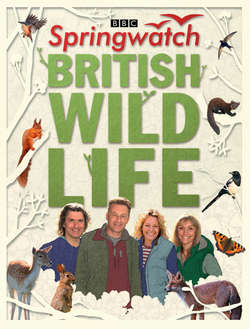Читать книгу Springwatch British Wildlife: Accompanies the BBC 2 TV series - Stephen Moss - Страница 7
ОглавлениеFinches
©Neil Bowman/FLPA
The chaffinch is our commonest finch, found in a wide range of wooded and garden habitats.
©Hugh Clark/FLPA
The goldfinch is currently on the increase, thanks partly to our habit of feeding birds in our gardens.
Of all our birds, there could hardly be a more colourful, attractive and better-known family than our finches. The dozen or so species of finch that regularly breed in Britain include some of our most familiar garden birds – the chaffinch, goldfinch and greenfinch – as well as some scarce and elusive ones such as the hawfinch and crossbill. Other species include the siskin and redpoll, which are growing in familiarity and now visit gardens more than they did in the past, and sadly declining species such as the bullfinch, linnet and twite.
Finches are seed-eaters, which means they have taken well to hanging feeders and bird tables containing either seeds or peanuts. Each species has subtly different food requirements, often leading to different-shaped bills. So, whereas the goldfinch has a slender, pointed bill, which it uses to extract the tiny seeds from thistles and teasels (and to take nyjer seed from garden feeders), the bullfinch has a much thicker, sturdier bill, which it uses to feed on buds. The hawfinch – the biggest British finch – sports a massive bill, which it uses to crack cherry stones, applying a pressure of more than two tons per square inch!
But of all the finches, by far the most bizarre feeding adaptation comes in the crossbills, whose various species have uniquely developed crossed mandibles: one half of their bill crosses over the other, enabling the birds to extract the seeds from pine cones and the fruits of other coniferous trees. Because they don’t depend on insects or fruit to feed their young, they nest remarkably early – sometimes beginning at the start of the new year. The crossbills are our only nomadic breeding bird, with flocks shifting around the country (and occasionally disappearing across the North Sea to Scandinavia) from year to year.
The group also includes Britain’s only endemic breeding bird, the Scottish crossbill, which is confined to a tiny area of the Caledonian pine forests of northeast Scotland.
Our commonest finch by far is the chaffinch, which, with more than five-and-a-half million breeding pairs, is second only to the wren as Britain’s commonest breeding bird. Chaffinches are found throughout the UK but are especially common in Scottish woodlands, where vast flocks gather to feed in winter. But, like other woodland birds, they have adapted well to living alongside us in our gardens.
Two other species – the greenfinch and the goldfinch – are even more dependent on garden bird-feeding; indeed, the goldfinch population has risen dramatically in the past couple of decades thanks to us providing high-energy food such as sunflower hearts. Today, the tinkling sound of a goldfinch flock can be heard in many gardens. Siskins – a streaky, smaller version of the greenfinch – have also learned to take advantage of our generosity, and have spread southwards from Scotland to southern England as a result.
One problem, though, has come with this success. Being sociable birds, often coming to gardens in flocks, finches are especially susceptible to disease, with greenfinches being hit particularly hard. It can be distressing to find dead birds underneath your feeders, so make sure you clean them thoroughly, and remove any mouldy food.
Some kinds of finch hardly ever come to gardens, and they are perhaps suffering as a result. Linnet and twite – two small, streaky finches with subtly beautiful plumage features – have both declined dramatically, and are now on the Red List of birds of conservation concern. Linnets are farmland birds, and changes in agricultural practices, such as the sowing of winter wheat, which has reduced the amount of stubble available for the birds to feed on in winter, have contributed to their decline. The decline of the twite is, in some ways, even more worrying; this moorland bird has virtually disappeared from northern England and now lives mainly in Scotland.
Finches build their open, cup-shaped nests hidden away in bushes, trees and shrubs. They mostly lay between four and six eggs, and usually raise two or even three broods of chicks during a single breeding season.
©Erica Olsen/FLPA
©Photo Researchers/FLPA
©John Hawkins/FLPA
©Paul Hobson/FLPA
All finches, including greenfinch, bullfinch, crossbill and siskin, have developed specially shaped bills to suit their favoured foods.
